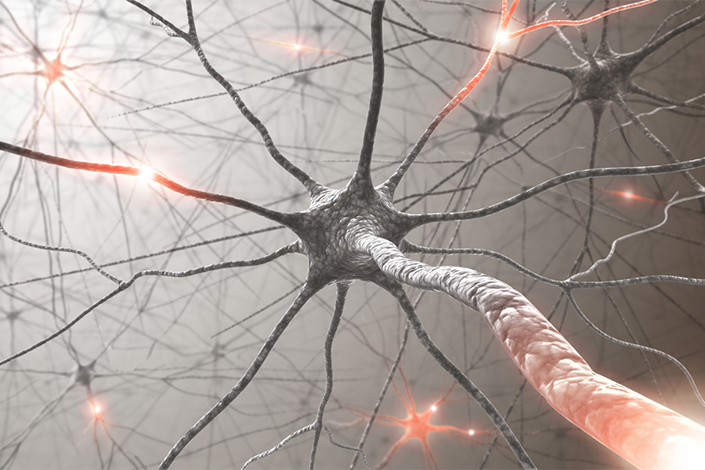Obrazy kliniczne w zespołach long-COVID i post-COVID Terapia 2022, 1 ( 408 ) : 42 - 47
Powikłania neurologiczne w zespole post-COVID
Neurological complications in post-COVID syndrome
Most of the neurological manifestations of post-COVID syndrome can be described as mild, however in some cases, serious complications may occur. A correlation between the severity of SARS-CoV-2 infection and the frequency and intensity of delayed manifestations can be observed.
Post-COVID patients most commonly suffered from fatigue and weakness. They often also experienced cognitive, memory and concentration impairments. Taste and smell disturbances may persist in a few to about a dozen percent of the patients. Autonomic nervous system disorders have also been reported. The symptoms include, but are not limited to, palpitations, chest pain and hypotension.
The increased cardiovascular risk has been already described in the first months of the pandemic. This included the increased probability of ischaemic and haemorrhagic stroke, especially in patients with severe cases of COVID-19. Taking into account some primary observations, the risk of vascular incidents may be increased not only in the acute phase of the disease, but also in post-COVID. However, there are still very few studies on this aspect. Singular cases of Guillain‒Barré and opsoclonus-myoclonus syndromes, which developed several weeks after SARS-CoV-2 infection have also been described.
Most of the papers on neurological manifestations of COVID-19 focus on the acute phase of the disease. Further research is required to identify key time windows, in which post-COVID patients should be under most scrutinous observation and care, as the data available today suggests, that COVID-19 may trigger numerous complications, manifesting themselves several weeks or even months after the acute SARS-CoV-2 infection.
Pandemia COVID-19, która miała swój początek w grudniu 2019 roku, szybko urosła do rangi ogólnoświatowego kryzysu. Do 22 listopada 2021 roku wirus SARS-CoV-2 spowodował ponad ćwierć miliarda potwierdzonych zakażeń, w tym ponad 5 milionów ze skutkiem śmiertelnym (1).
Już od ponad trzydziestu lat mamy wiedzę o neuroinwazyjnym i neurotropicznym charakterze koronawirusów (2). Również w przypadku SARS-CoV-2 od początku pandemii obserwowaliśmy liczne doniesienia o neurologicznych manifestacjach infekcji (3). Z powodu braku długoterminowego doświadczenia, opisywane były głównie ostre powikłania CO-VID-19. Obecnie jednak coraz częściej można się spotkać z podejrzeniami przewlekłych skutków, jakie infekcja (w tym z zajęciem układu nerwowego) SARS-CoV-2 może powodować.

Zaloguj się i przeczytaj bezpłatnie całą treść artykułu.
Nie masz jeszcze konta dostępowego?
Zarejestruj się bezpłatnie, a otrzymasz:
* dostęp do wszystkich doniesień oraz pełnych tekstów artykułów naukowych w naszej Czytelni,
* prawo do bezpłatnego otrzymywania newslettera "Aktualności TERAPIA" z przeglądem interesujących i przydatnych wiadomości ze świata medycyny oraz systemu ochrony zdrowia w Polsce i na świecie,
* możliwość komentowania bieżących wydarzeń oraz udziału w ciekawych quizach i konkursach.
Zapraszamy serdecznie, dołącz do naszej społeczności.



Dodaj komentarz